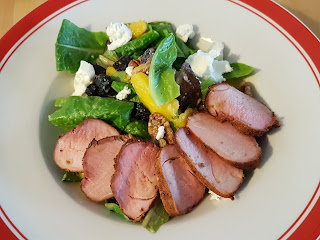A new twist on an old favourite...baked polenta. This was my way of using up 3 artichoke hearts, some sliced bocconcini and half a can of tomatoes...a very tasty way to do so, if I may say so! We finished the rest off for lunch today, and it was even better than it was last night. This is a good sign, as it means making it ahead works, which can be a great time saver.
I used the canned tomatoes to make a quick tomato sauce, with onion, garlic, tomato paste and oregano. I also added a bit of sugar to counteract the acidity.
The bocconcini on the top melted and crisped up, the cheese inside stayed nice and gooey. I kept the polenta layers thin, so the overall effect wasn't too heavy.
Start off by making a batch of polenta as shown in the post Polenta Baked with Italian Sausage and Tomatoes.
Line a 10" square pan with plastic wrap and spread the polenta evenly in the pan. Wrap and allow to cool in the fridge for a few hours, or overnight.
Tip the cooled polenta out of the pan, unwrap it and cut it into 3 equal pieces.
Line a loaf pan with foil, and lightly grease the foil.
Place one of the pieces of polenta into the pan.

Place on top of the polenta:
2 bocconcini slices, torn into smaller pieces
1 1/2 artichoke hearts, roughly chopped
1 tablespoon chopped fresh basil
Ground black pepper
Cover this with:
1/3 cup tomato sauce
Repeat these layers with the second piece of polenta, and then finish off by placing the last piece of polenta on top.
Cover the polenta with:
1/3 cup tomato sauce
4 slices of bocconcini
If you have tomato sauce left over, spoon it down the sides of the pan. I had about 1/2 cup left over to use in this way.
Place into a pre-heated 350F oven, and bake until it is hot in the middle, the sauce is bubbling and the cheese on top is golden.
This should take between 30 - 45 minutes.
Remove from the oven and leave to set for 5 minutes, before serving.
I used each piece of cheese on top as a portion guide, so we each had a piece for dinner, and another for lunch today! Cut it into smaller pieces if that is what you would prefer.
- You can make a larger amount of polenta and layer this in a square pan if you choose; I made 2/3 of the recipe and used an 8" pan to spread the polenta and an 8" X 5" loaf pan. Try and keep the polenta no more than 3/4" thick if you can.
- Lining the loaf pan with foil makes serving easy...simply lift the foil out of the pan, gently push the sides down and slice.
- As I mentioned at the beginning of the post, this can be assembled a day ahead.
- I served this with pork, but it can be the main meal, especially if you add more vegetables or meat to the layers.
- Vegetables that can be added include: spinach; grilled peppers, zucchini, mushroom, eggplant; cooked leeks; olives; asparagus.
- Meat that can be added: any leftover cooked meat, diced or thinly sliced; cooked and crumbled sausage; ham, prosciutto or bacon.
- Use a purchased tomato sauce to save time, or Basic Tomato Sauce if you have some in the freezer.
- Pesto or tapenade can be used instead of fresh basil.
- Grated mozzarella, feta cheese or soft goat cheese can also be used.























































